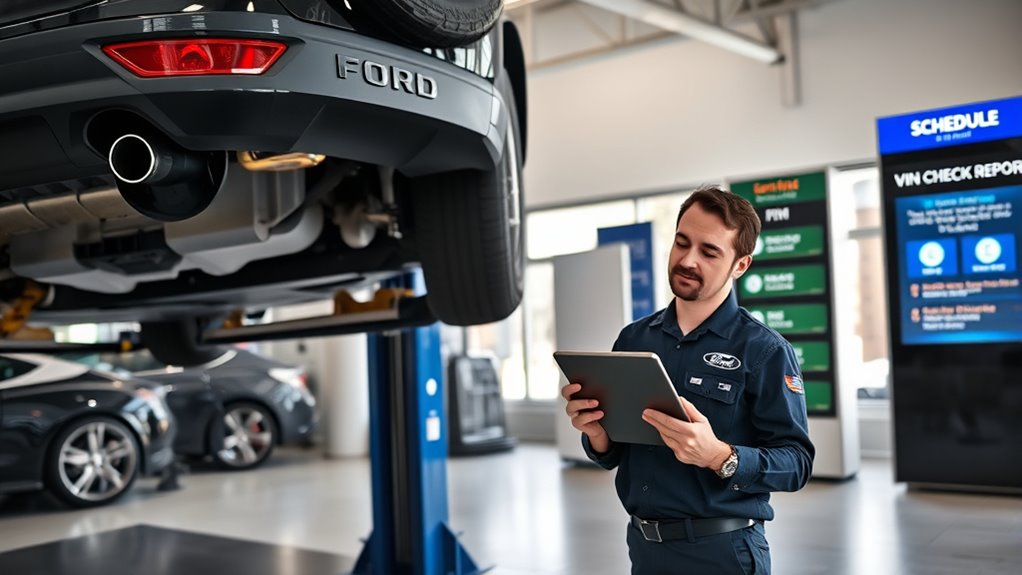When Ford issues a recall, you can verify if your vehicle is affected by entering your VIN on their official website or NHTSA’s site. If your vehicle is recalled, Ford typically sends a notification by mail with repair instructions. You then schedule a free repair appointment at your local dealer, where trained technicians handle the fix and update your vehicle records. To learn more about how this process guarantees your safety, continue exploring the details.
Key Takeaways
- Enter your vehicle’s 17-character VIN on Ford’s official recall website or NHTSA site to check for recalls.
- Ford mails recall notices with repair details shortly after an issue is identified.
- Affected owners should promptly schedule free repairs with authorized dealerships.
- When scheduling, mention the recall to ensure technicians perform the necessary fix.
- Repair times vary; dealerships may offer loaner vehicles or shuttle services during service.

If you own a Ford vehicle, staying informed about recalls is vital for your safety and peace of mind. Ford regularly issues recalls when safety or quality issues are identified, and knowing how the process works helps you respond quickly. The key to staying ahead is understanding VIN checks and dealer scheduling.
Your Vehicle Identification Number (VIN) is a unique 17-character code that Ford uses to identify your specific vehicle. When a recall is announced, Ford’s system uses your VIN to determine if your vehicle is affected. This process guarantees that only the vehicles with the identified issues are flagged, preventing unnecessary repairs or appointments.
Your 17-character VIN uniquely identifies your Ford and helps determine if a recall affects your vehicle.
To check if your Ford needs a recall repair, you can visit Ford’s official recall website or the National Highway Traffic Safety Administration (NHTSA) site. Simply enter your VIN, and the system will tell you if your vehicle is impacted by any current recalls. You don’t have to wait for a recall notice in the mail; the online tools are quick and reliable, giving you peace of mind.
If your vehicle is affected, Ford will notify you by mail, usually within a few weeks of the recall being announced. The letter will include details about the recall and instructions for getting the repair done.
Once Ford confirms that your vehicle is part of a recall, the next step is scheduling a repair appointment. Ford’s dealer network makes this process straightforward. You can call your local dealership or use Ford’s online scheduling tool to book an appointment.
When you do, be sure to mention the recall so the service advisors are prepared. Ford typically offers free repairs for recalls, covering parts and labor, so you shouldn’t expect to pay anything out of pocket. It’s a good idea to check with your dealer about the estimated repair time and if a loaner vehicle or shuttle service is available, especially if the repair might take a few hours.
Scheduling is simple and flexible, allowing you to choose a time that fits your schedule. Once at the dealership, trained technicians will perform the necessary repairs based on Ford’s recall instructions. They’ll also verify that your vehicle is safe to drive before you leave.
After the repair, Ford often updates your vehicle’s records and provides documentation confirming the work was completed. Staying proactive by checking your VIN regularly, responding promptly to recall notices, and scheduling repairs at your convenience keeps your Ford running safely and reliably.
This process isn’t complicated, but it’s essential for maintaining your vehicle’s safety and value.
Frequently Asked Questions
How Long Does a Ford Recall Repair Typically Take?
A Ford recall repair typically takes a few hours to a full day, depending on the issue’s complexity.
When you visit the dealer, they’ll schedule the repair based on parts availability and the severity of the recall. Sometimes, if parts are in stock, the fix can be done quickly, often within a few hours.
For more complex repairs or if parts need to be ordered, it might take longer.
Can I Get a Loaner Car During the Recall Repair?
Irony strikes again—you might get a loaner car during a recall repair, but don’t count on it automatically. Ford dealerships often offer loaner vehicles if parts are delayed or repairs take longer than expected.
You should check with your dealer ahead of time to see if a loaner is available for your specific recall. It’s not guaranteed, but asking early could save you some inconvenience.
Are Recall Repairs Covered Under Warranty?
Yes, recall repairs are typically covered under your vehicle’s warranty, so you usually won’t have to pay out of pocket. Ford makes sure that safety-related fixes are free for you.
Just bring your car to the dealership, and they’ll handle the repair at no cost. Keep in mind, warranty coverage details can vary, so it’s a good idea to confirm with your dealer or check your warranty terms.
What Should I Do if My VIN Isn’T Recognized?
If your VIN isn’t recognized, don’t worry. First, double-check the number to confirm it’s correct.
If it still isn’t found, contact your Ford dealer directly for assistance. They can verify your vehicle’s details and clarify if it’s part of an active recall.
You might also visit Ford’s official website or customer service for further support.
Acting quickly helps ensure your vehicle stays safe and up-to-date.
How Often Does Ford Issue Recalls for Specific Models?
Think of Ford recalls like seasonal storms—they happen unpredictably but often for safety. The frequency varies by model and year, with some experiencing recalls multiple times, while others rarely do.
Ford issues recalls whenever safety or quality concerns arise, driven by safety investigations or customer reports.
Conclusion
Now that you understand how Ford recalls work, including VIN checks and dealer scheduling, you’re better equipped to handle the process. Remember, staying proactive is key—don’t wait until it’s too late. Keep an eye out for recall notices and act quickly to get your vehicle fixed. After all, it’s better to be safe than sorry, so don’t let a small issue turn into a big problem down the road.









